The era of the EXTRATERRESTRAZOICUM
by Gerard 't Hooft
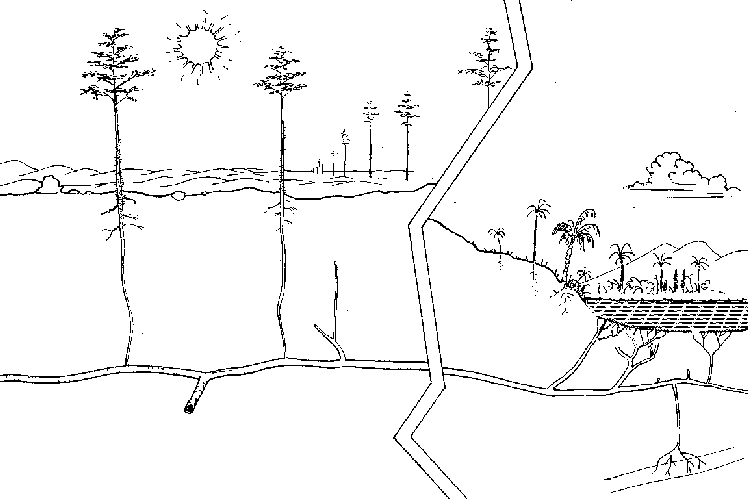
When toxic
materials saturate the soils, oceans and atmosphere, when
oceans become acid and the oxygen contents of the air drops to dangerously low
levels, humanity will decide to leave. In new habitats on the Moon and
in outer space, humans will
enjoy the unprecedented luxury of low or vanishing gravity. By that time,
most of the earth's surface has turned into desert. But life is
stubborn. The polluticum will not last forever.
Helped by smart genetic engeneers, plants find new ways to reconquer the desert.
This happens as follows. The
Woestijnpijpleidingboompjes develop a unique root system.
Indeed, most of these plants stays burrowed deeply below the surface. Their roots reach
far down into water vains, or find their way to distant rivers. When sprouts do emerge above
the soil, they first develop sharp thorns to avoid being eaten by thirsty animals,
and only very high up you will find the leaves, needed for photosynthesis.
The plants procreate sexually when different root systems meet underground.
Eventually, they manage
to redistribute water all over the desert, and they create dense, shady forests.
Rain returns to these regions, and finally many plants and animals thrive, not unlike what
happens today near coral reeves.
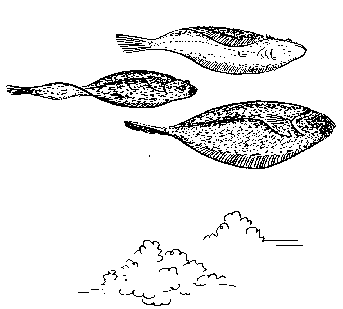
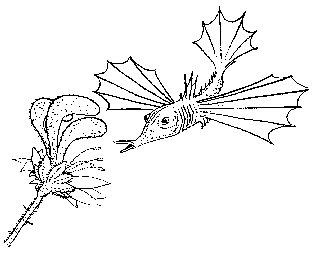
Flying fish are admirable
creatures. They managed to conquer the skies directly from the water, unlike the birds,
which evolved slowly from reptiles, having ample opportunity to practice flying by
dropping from low tree branches while flapping their paws. Fish had to leave the water
under much more difficult circumstances. Bravo. now they have a great future.
The hummingbird fish (Dactylopter minimus) plays an
important role in pollinating the Vishoningroosje.
Flying soles (Vliegende schollen, Limania mysteriosa) were
sometimes mistaken for UFO's (vliegende schotels).
These fish, however, have one thing
in common with birds and flying mammals: they use wings to fly. Of course, this implies
a limitation: they'll never be able to leave the earth's atmosphere.
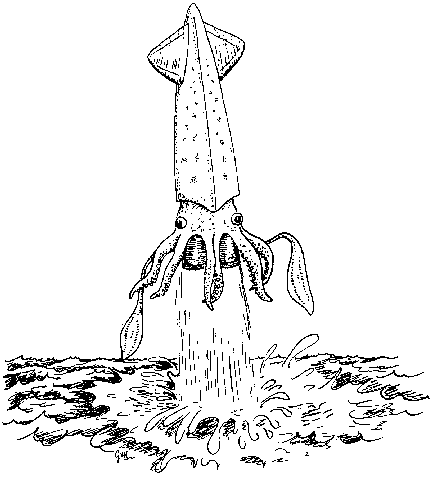 To leave the atmosphere, what is
needed is a reaction engine. It is not so well-known among the public, but reaction engines
already exist in Nature: the squids. Squids possess a propulsion siphon, which, when emptied
rapidly, gives the animal a sudden momentum, in a direction unexpected by its enemies
(it also uses the siphon for discharging ink). What a great future must there be
ahead of them! all they need to do in order to reach the next level in evolution,
is to collect chemical explosives. This is not a hard thing to do in the Polluticum.
Once they learn how to ignite these explosives, the propulsive power of squids will
be great enough to leave the water and join the flying fish. See the picture here of
Sepia Explosiva.
To leave the atmosphere, what is
needed is a reaction engine. It is not so well-known among the public, but reaction engines
already exist in Nature: the squids. Squids possess a propulsion siphon, which, when emptied
rapidly, gives the animal a sudden momentum, in a direction unexpected by its enemies
(it also uses the siphon for discharging ink). What a great future must there be
ahead of them! all they need to do in order to reach the next level in evolution,
is to collect chemical explosives. This is not a hard thing to do in the Polluticum.
Once they learn how to ignite these explosives, the propulsive power of squids will
be great enough to leave the water and join the flying fish. See the picture here of
Sepia Explosiva.
Sepia will be able to
make excursions into the stratosphere. It will need a thorough revision of its
breathing system, holding its air for hours, but this is nothing new. Under water,
whales, seal and dolphins can also hold their breath for long periods of time.
Squids will learn how to go into Earth orbit.
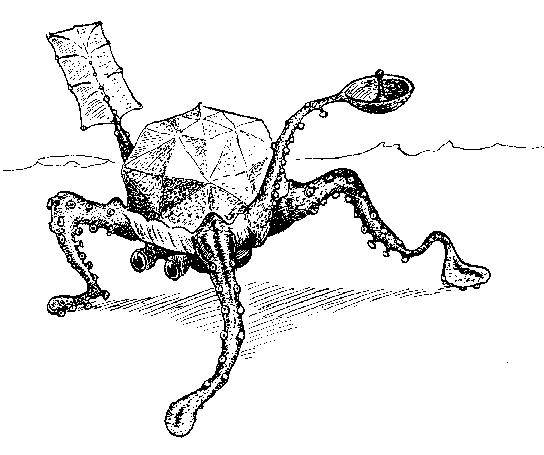 Eventually and inevitably, squids
will land on the Moon. The first one, the Moonsquid, Antennapes
Charliebrown, will be wellcomed by television crews. Humans, after all,
conquered the Moon much earlier. But, needless to say, this is only the beginning of
the Extraterrestrazoicum.
Eventually and inevitably, squids
will land on the Moon. The first one, the Moonsquid, Antennapes
Charliebrown, will be wellcomed by television crews. Humans, after all,
conquered the Moon much earlier. But, needless to say, this is only the beginning of
the Extraterrestrazoicum.
Perhaps it starts millennia from now!
Back:
See the Other eras
Back to Gerard 't Hooft's homepage.



 To leave the atmosphere, what is
needed is a reaction engine. It is not so well-known among the public, but reaction engines
already exist in Nature: the squids. Squids possess a propulsion siphon, which, when emptied
rapidly, gives the animal a sudden momentum, in a direction unexpected by its enemies
(it also uses the siphon for discharging ink). What a great future must there be
ahead of them! all they need to do in order to reach the next level in evolution,
is to collect chemical explosives. This is not a hard thing to do in the Polluticum.
Once they learn how to ignite these explosives, the propulsive power of squids will
be great enough to leave the water and join the flying fish. See the picture here of
Sepia Explosiva.
To leave the atmosphere, what is
needed is a reaction engine. It is not so well-known among the public, but reaction engines
already exist in Nature: the squids. Squids possess a propulsion siphon, which, when emptied
rapidly, gives the animal a sudden momentum, in a direction unexpected by its enemies
(it also uses the siphon for discharging ink). What a great future must there be
ahead of them! all they need to do in order to reach the next level in evolution,
is to collect chemical explosives. This is not a hard thing to do in the Polluticum.
Once they learn how to ignite these explosives, the propulsive power of squids will
be great enough to leave the water and join the flying fish. See the picture here of
Sepia Explosiva.  Eventually and inevitably, squids
will land on the Moon. The first one, the Moonsquid, Antennapes
Charliebrown, will be wellcomed by television crews. Humans, after all,
conquered the Moon much earlier. But, needless to say, this is only the beginning of
the Extraterrestrazoicum.
Eventually and inevitably, squids
will land on the Moon. The first one, the Moonsquid, Antennapes
Charliebrown, will be wellcomed by television crews. Humans, after all,
conquered the Moon much earlier. But, needless to say, this is only the beginning of
the Extraterrestrazoicum.